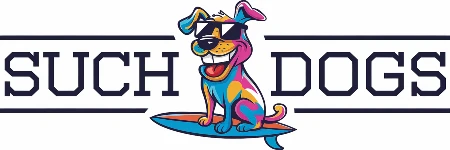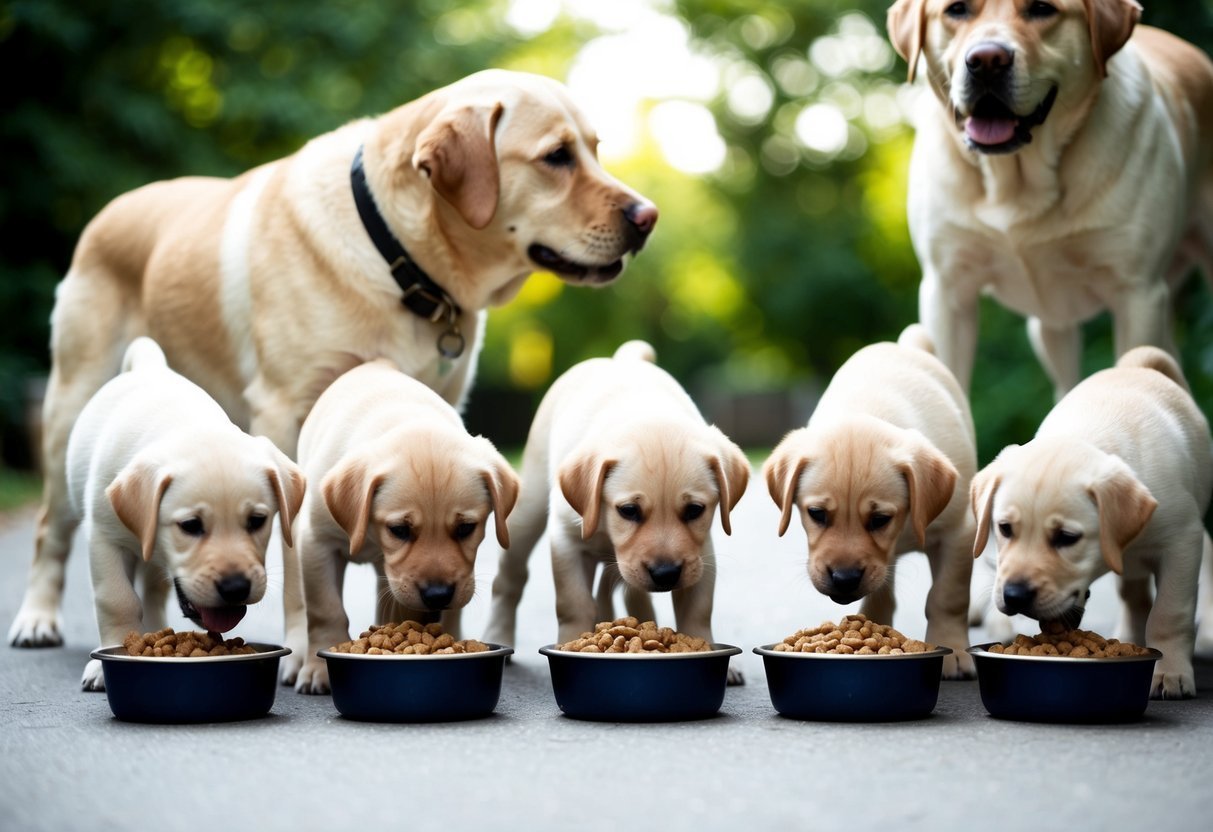Feeding a Labrador puppy can seem tricky, but it doesn’t have to be overwhelming. Understanding the essential feeding rules can help you ensure your pup grows healthy and strong.
Knowing how much and when to feed your puppy is vital for their development and can set the foundation for a happy life.
Many new puppy owners have questions about the best practices for feeding.
You want to give your Lab the nutrition they need, but it’s important to follow some basic guidelines.
These six feeding rules will guide you in providing the best diet for your furry friend.
1) Feed High-Quality Puppy Food
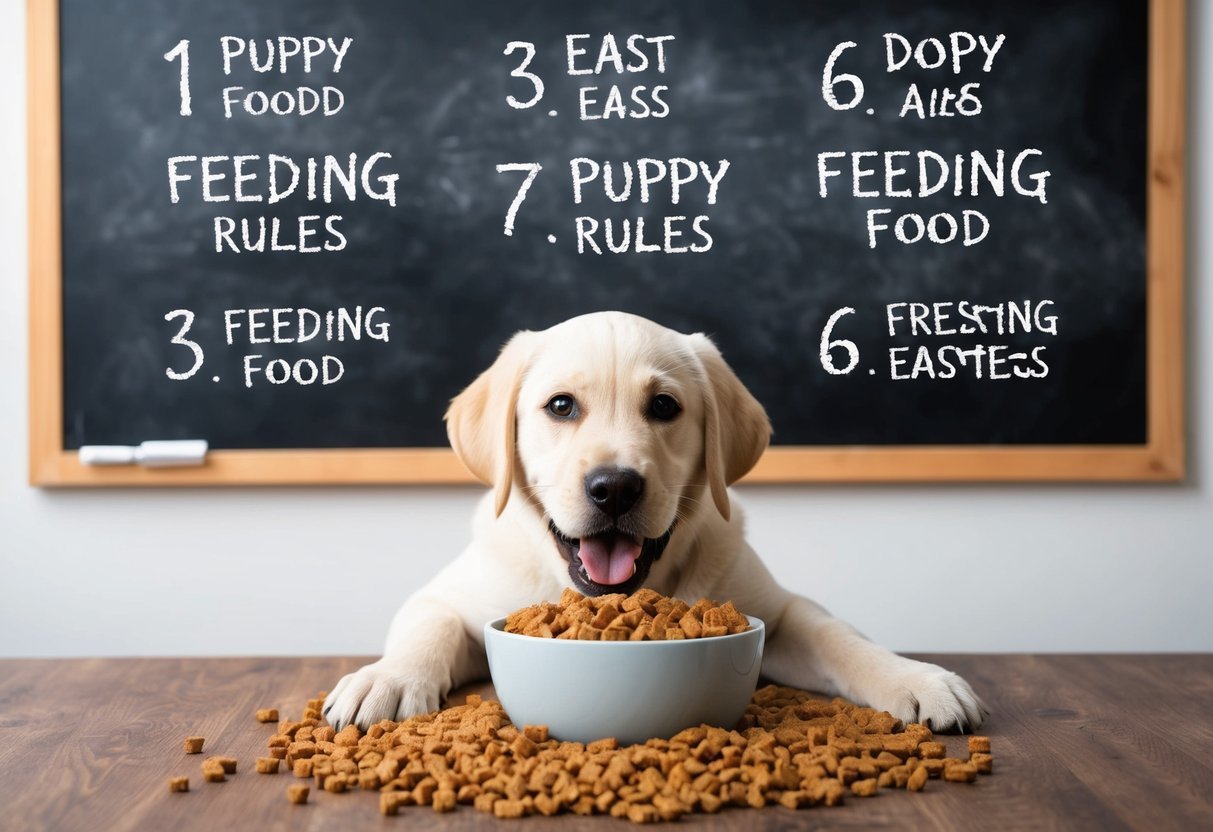
Choosing high-quality puppy food is essential for your Lab’s growth and health.
A good puppy food is designed to meet the specific needs of your growing dog.
Look for food that lists meat as the first ingredient.
This indicates a high protein content, which is vital for muscle development.
Avoid foods with too many fillers, like corn or soy.
These don’t provide the nutrients your puppy needs.
Nutrients like fats, vitamins, and minerals are crucial too.
They help with brain development and healthy bones.
Make sure the food you choose has a balance of these elements.
Consider different types of food, such as kibble, wet food, or raw options.
Each has its benefits, but the key is that it should be complete and balanced.
Always check that the food meets the AAFCO standards for puppies.
You may want to consult your vet about the best choice for your puppy.
Remember, starting with high-quality food sets your Lab on the right path for a healthy life.
Establish a Consistent Feeding Schedule
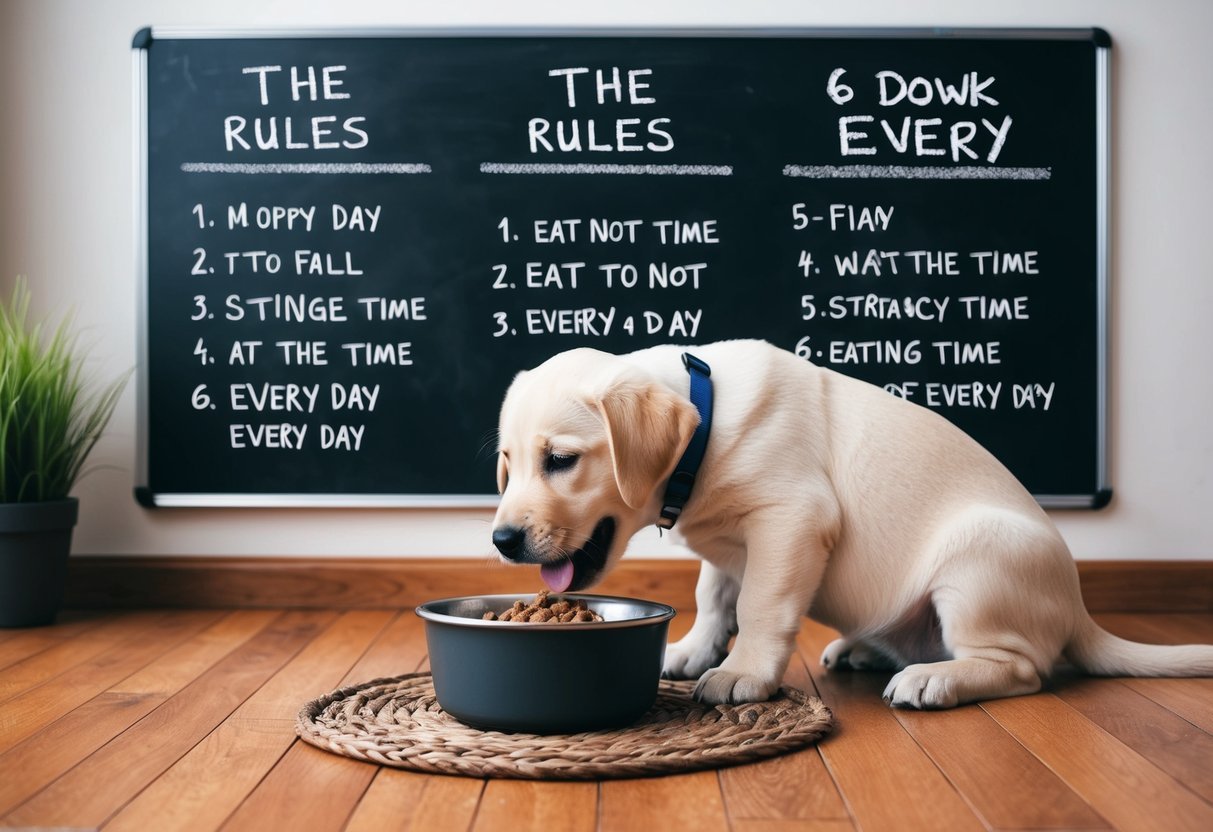
A consistent feeding schedule is key for your lab puppy.
It helps them know when to expect meals, which can make them feel safe and secure.
Feed your puppy three to four times a day until they reach about six months old.
This frequent feeding supports their growth and energy needs.
After six months, you can switch to feeding them twice a day.
Try to keep the feeding times the same each day.
This routine can help with digestion and regulate their appetite.
For example, if you feed them at 7 AM, keep that time daily.
Also, make sure to space the meals out evenly.
Aim for mealtimes four to six hours apart.
This way, your puppy will have enough time to digest before the next meal.
By sticking to a schedule, you help your puppy develop a healthy eating habit.
It can also make potty training easier since you’ll know when they need to go outside after eating.
3) Provide Fresh Water Daily
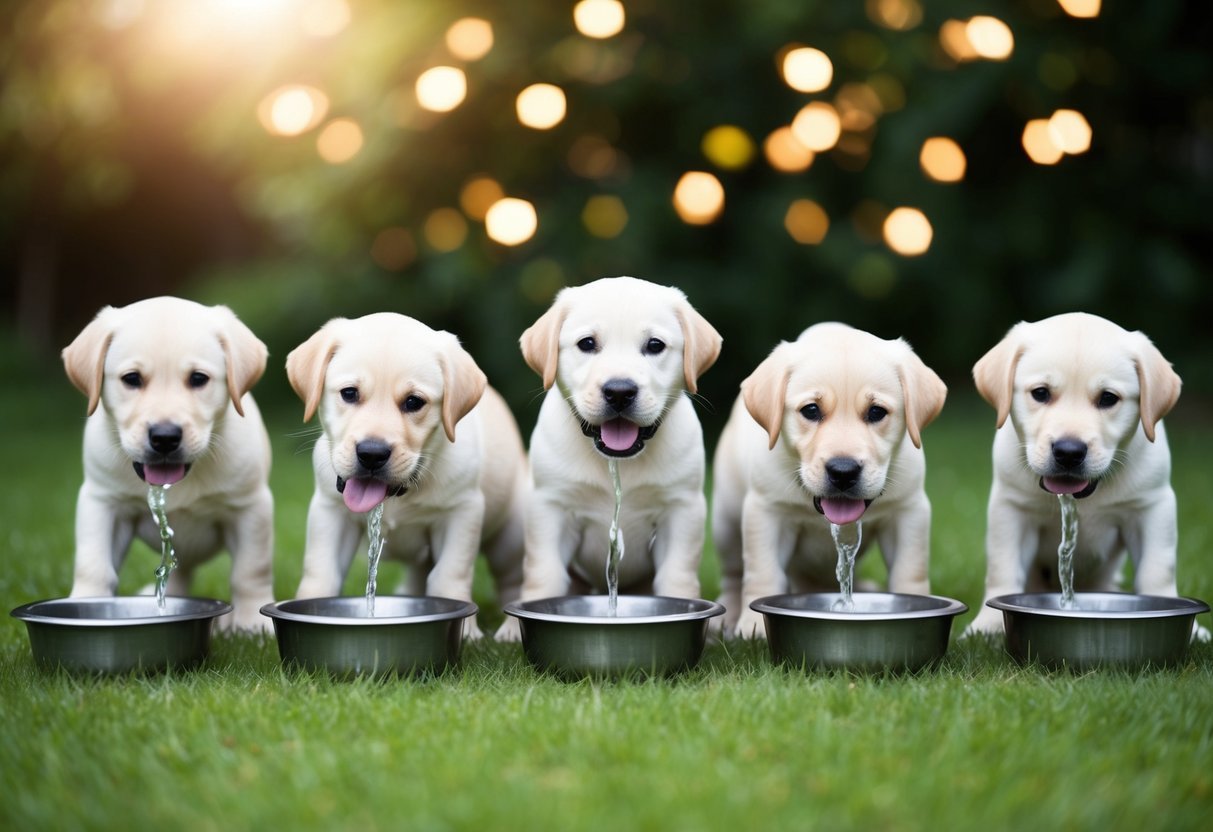
Your Lab puppy needs plenty of fresh water every day.
Water is essential for their growth and health.
Dehydration can lead to serious health issues, so make sure your puppy always has access to clean water.
You should change the water daily to keep it fresh.
Puppies are curious and might splash or play in their water bowl.
Clean it regularly to remove any dirt or bacteria.
A good rule is to offer water after meals and playtime.
This helps your puppy stay hydrated and supports digestion.
If your puppy is very active, they may need more water.
Consider getting a water bowl that is sturdy.
Puppies can be messy, and a spill-proof bowl can help reduce cleanup.
Make sure the bowl is the right size for your pup.
Keeping water available encourages good habits.
It helps your Labrador grow healthy and strong.
Plus, a well-hydrated puppy is often more energetic and playful.
Always be attentive to your puppy’s needs when it comes to hydration.
4) Avoid Overfeeding
When feeding your lab puppy, it’s easy to go overboard.
Puppies often seem hungry all the time, but sticking to a proper feeding routine is key.
Overfeeding can lead to serious health issues like obesity.
This not only affects their weight but can also harm their joints and overall health.
Keep an eye on portion sizes to ensure you’re not giving too much food.
Instead of free-feeding, opt for small, regular meals throughout the day.
This helps with digestion and keeps your puppy from eating too quickly.
Always follow the guidelines on your puppy’s food label and consult your vet for specific advice tailored to your pup’s needs.
Measuring out food instead of guessing can be a game changer.
Remember, a healthy diet now sets the stage for a happy, active adult dog later.
Stay diligent about feeding, and your lab puppy will thank you with plenty of energy and love.
5) Incorporate Healthy Treats Sparingly
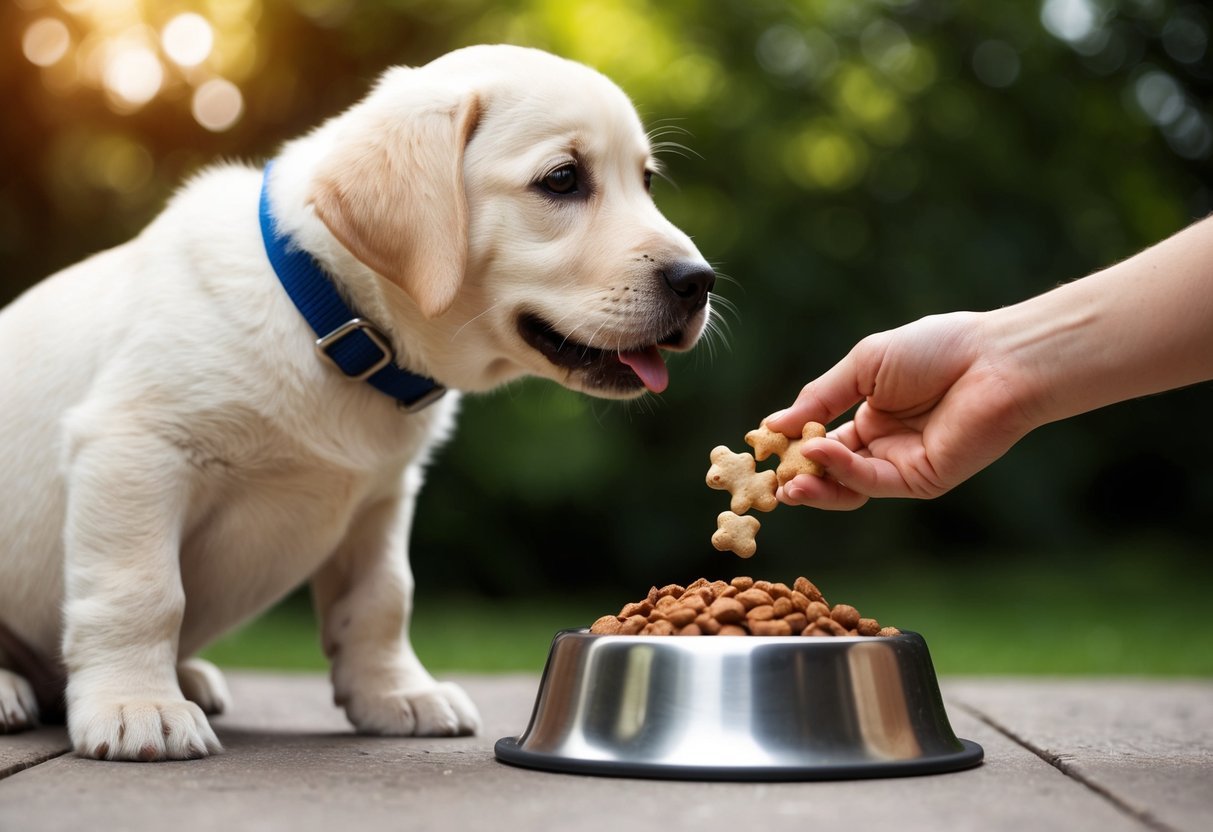
When it comes to giving your Lab puppy treats, moderation is key.
Healthy treats can be a great way to reward your pup, but too many can lead to weight gain and health issues.
Choose treats that are low in calories and made with good ingredients.
You can offer small pieces of fruits or vegetables like carrots or apples.
Just make sure to avoid items that are toxic to dogs, like grapes or onions.
Timing matters too.
Use treats during training sessions or to reinforce good behavior.
This way, your puppy learns to associate treats with positive actions.
Remember, treats should not make up more than 10% of your puppy’s daily calorie intake.
Keeping the balance ensures your puppy stays healthy while still enjoying tasty rewards.
Be sure to check the ingredient lists and portion sizes.
6) Transition to Adult Food at One Year
When your lab puppy reaches about one year old, it’s time to think about switching to adult dog food.
This change is important for their growth and health.
By this age, your lab’s growth rate slows down.
The nutritional needs of an adult dog are different from a growing puppy.
Choosing the right food will help maintain a balanced diet.
To make this transition, start mixing adult food with their puppy food.
For the first few days, you can add a little adult food to their regular meals.
Gradually increase the amount over a week.
This slow transition helps prevent stomach issues.
You want your pup to adjust smoothly without any tummy troubles.
If you have a larger lab, you might consider waiting until they are 18 months.
It’s always good to consult your vet for the best advice on timing and food selection.
Making this switch not only supports their health but also keeps their energy levels up as they enter adulthood.
Understanding Your Lab Puppy’s Nutritional Needs
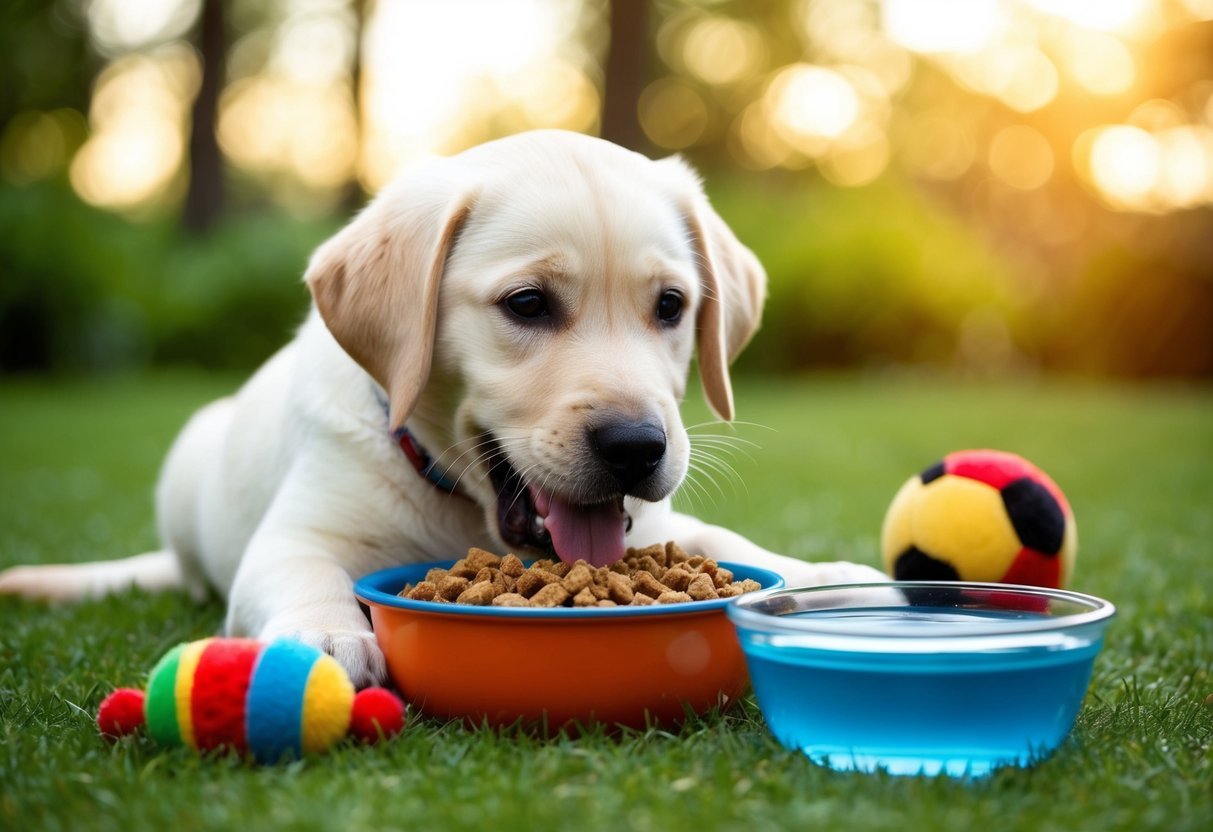
Your Lab puppy’s nutrition is crucial for healthy growth and development.
Understanding the specific dietary requirements at different stages will help ensure your pup gets the right balance of nutrients.
Growth Stages and Dietary Requirements
Lab puppies go through several growth stages, and their dietary needs change rapidly.
During the first few weeks, they rely heavily on their mother’s milk or a puppy milk replacer if needed.
As they grow, you’ll typically introduce solid food around 4 weeks.
At this age, you should provide a high-quality puppy food designed for large breeds.
This helps support their rapid growth without causing obesity.
By six months, they may need three meals a day.
Then, as they approach adulthood, you can switch to two meals daily.
Keep track of their weight and adjust the food amount as their growth slows down.
Nutrient Essentials for Puppies
Puppies need a balanced diet rich in specific nutrients.
Here are key components to focus on:
- Protein: Essential for growth, it should come from high-quality sources like chicken, lamb, or fish.
- Fats: Healthy fats support brain development. Look for sources like fish oil and flaxseed.
- Carbohydrates: Provide energy but ensure they come from whole grains and vegetables.
- Vitamins and Minerals: Critical for overall health, especially calcium and phosphorus for bone growth.
Make sure your puppy food contains adequate amounts of these nutrients to support healthy development.
Checking feeding charts can help guide you on how much to feed based on your pup’s age and weight.
Portion Control and Feeding Schedule
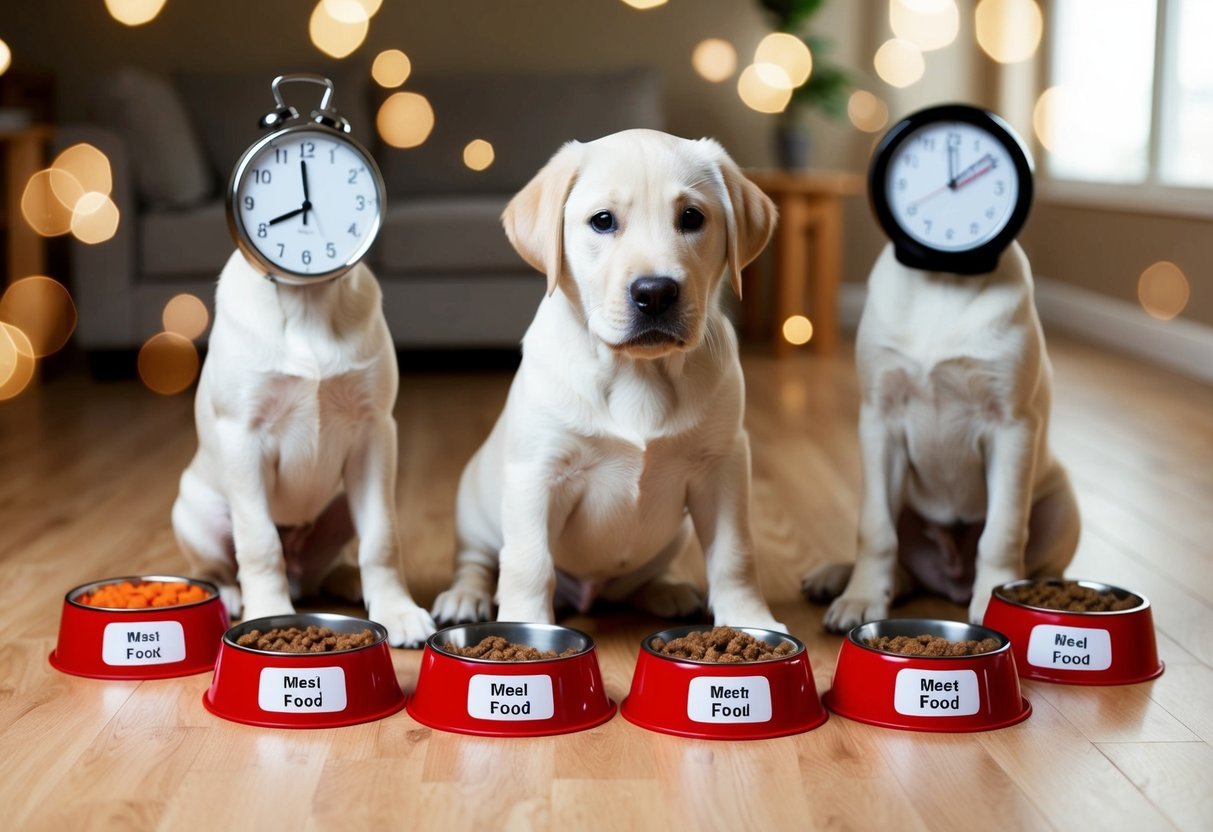
Establishing a proper feeding schedule and portion control is essential for your Lab puppy’s growth and health.
It helps prevent overeating and ensures your puppy gets the right nutrients at the right time.
Setting Up a Feeding Routine
Start by choosing specific times to feed your puppy each day.
Consistency is key.
Aim for three to four meals a day, especially for puppies under six months.
Use the following guidelines for portion sizes:
- 8 to 12 weeks: 2 to 3 cups of food daily, divided into 3-4 meals.
- 3 to 6 months: 3 to 4 cups of food daily, split into 3 meals.
- 6 months to 1 year: 4 to 6 cups daily, divided into 2 meals.
Monitor your puppy’s weight and adjust the amounts as needed.
Always provide fresh water and avoid table scraps.
Following this routine can help your Lab puppy grow into a healthy adult dog.
Signs of Overfeeding or Underfeeding
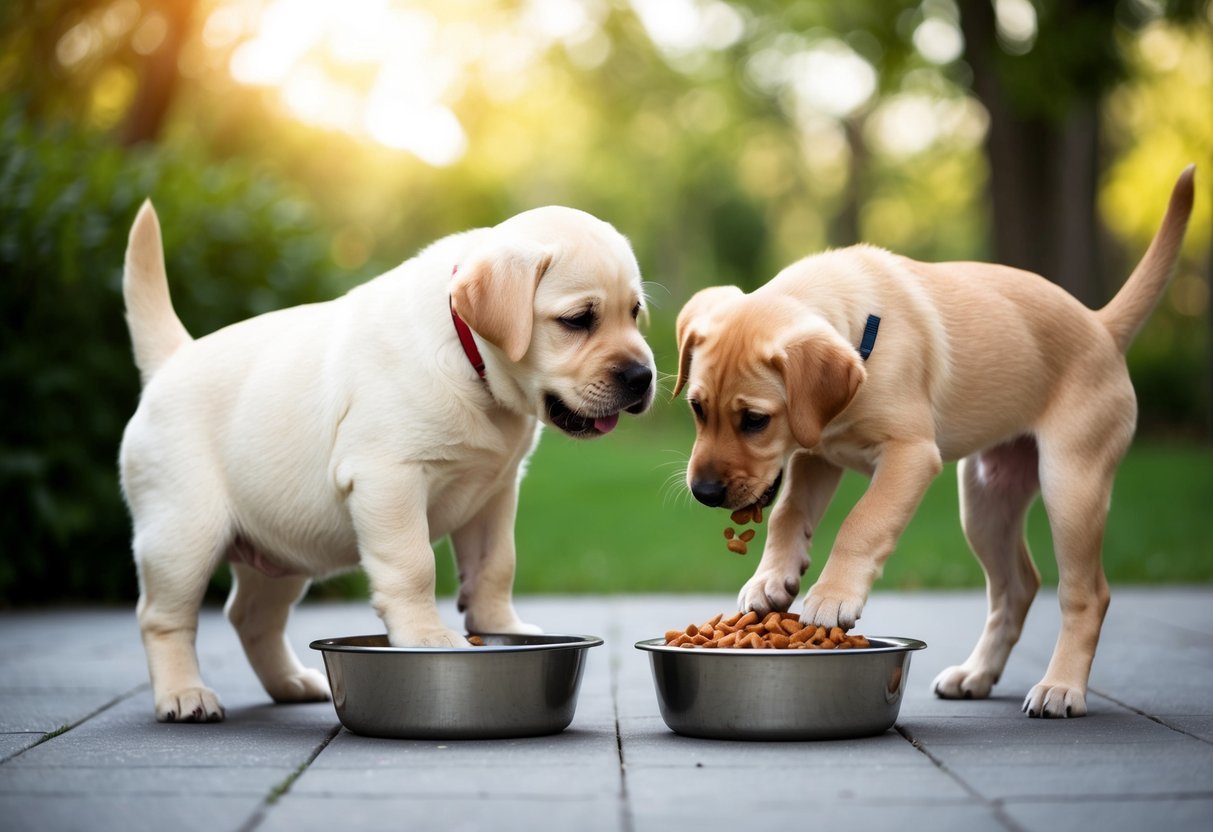
Being careful about how much you feed your puppy is important.
Here are some signs to watch for:
Signs of Overfeeding:
- Weight Gain: If your puppy seems to be gaining weight rapidly, it might be a sign of overfeeding.
- Lethargy: Overeating can make your puppy feel tired and less active.
- Digestive Issues: Look for signs like vomiting or diarrhea.
Signs of Underfeeding:
- Thin Body Condition: You should be able to feel your puppy’s ribs, but they shouldn’t be sticking out.
- Constant Hunger: If your puppy seems hungry all the time, it might not be getting enough food.
- Low Energy: A puppy that lacks energy may not be getting enough nutrients.
Behavioral Changes:
Both overfeeding and underfeeding can affect your puppy’s behavior.
Watch for signs like being anxious, clingy, or acting out.
If you notice any of these signs, it’s a good idea to consult your vet.
They can help you set a proper feeding plan to keep your lab puppy healthy.
Frequently Asked Questions

Feeding your lab puppy can bring up a lot of questions.
Let’s break down some common concerns that many pet owners have about their pup’s diet.
What’s the right amount of food to give my lab puppy?
The amount of food depends on your puppy’s age and weight.
Typically, a lab puppy will need about 2 to 3 cups of high-quality puppy food a day.
It’s best to divide this into several meals to aid digestion.
How often should I be feeding my lab pup throughout the day?
Young puppies usually eat three to four times a day.
As they grow, you can reduce it to two meals.
Keeping a consistent schedule helps with their eating habits and digestion.
What’s the scoop on how much my 6-month-old lab should be chowing down?
At six months, your lab should eat around 3 to 4 cups of puppy food daily.
Make sure you’re still watching their weight.
Adjust the food if your puppy is gaining too much or not enough weight.
Can I overdo it with the kibble for my lab puppy, or is more actually better?
Yes, you can overdo it.
Overfeeding can lead to obesity and related health issues.
Always stick to the recommended amounts and observe your puppy’s activity level and body condition.
Do puppies like labs need a nighttime snack, or should dinner be the last call?
Most puppies do not need a nighttime snack.
It’s better to have their last meal in the evening, a few hours before bedtime.
This helps avoid late-night bathroom trips and ensures a good night’s sleep.
Should a puppy’s diet change as they grow, and how can I track that?
Yes, a puppy’s diet should change as they grow.
You can start transitioning to adult food around one year old.
Tracking their growth with a growth chart can help you determine when to make adjustments in their diet.
